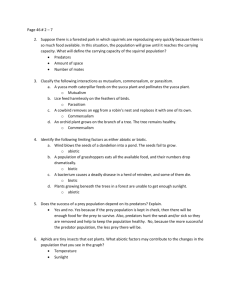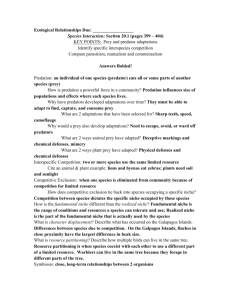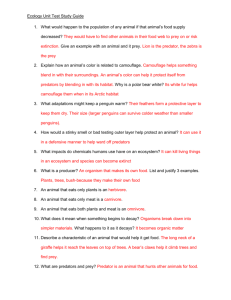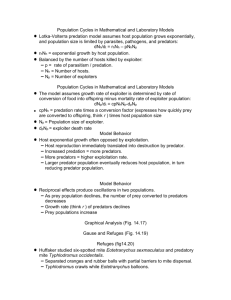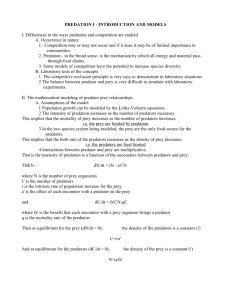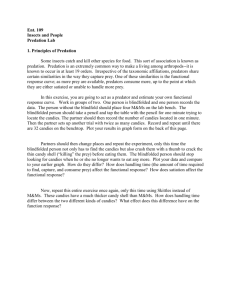Biotic and Abiotic Interactions
advertisement
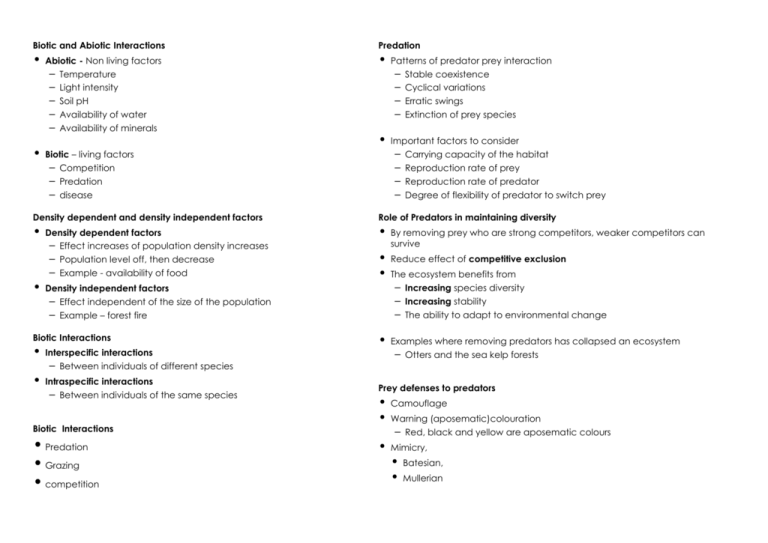
Biotic and Abiotic Interactions Predation • • Patterns of predator prey interaction – Stable coexistence – Cyclical variations – Erratic swings – Extinction of prey species • Important factors to consider – Carrying capacity of the habitat – Reproduction rate of prey – Reproduction rate of predator – Degree of flexibility of predator to switch prey • Abiotic - Non living factors – Temperature – Light intensity – Soil pH – Availability of water – Availability of minerals Biotic – living factors – Competition – Predation – disease Density dependent and density independent factors Role of Predators in maintaining diversity • • By removing prey who are strong competitors, weaker competitors can survive • • Reduce effect of competitive exclusion • Examples where removing predators has collapsed an ecosystem – Otters and the sea kelp forests • Density dependent factors – Effect increases of population density increases – Population level off, then decrease – Example - availability of food Density independent factors – Effect independent of the size of the population – Example – forest fire Biotic Interactions • • Interspecific interactions – Between individuals of different species Intraspecific interactions – Between individuals of the same species Biotic Interactions • Predation • Grazing • competition The ecosystem benefits from – Increasing species diversity – Increasing stability – The ability to adapt to environmental change Prey defenses to predators • • Camouflage • Mimicry, Warning (aposematic)colouration – Red, black and yellow are aposematic colours • • Batesian, Mullerian Grazing • A grazer is defined as – Niche • Any species that moves from one victim to another, feeding on part of each victim without actually killing it outright • E.g. eating a shoot or a limb • Can increase or decrease species diversity depending on grazing • pressure. Grazing of Vegetation • Plant species with basal meristems can be grazed without suffering mortality • Plant species with aerial meristems can be eliminated by grazing when the aerial part is removed. • Grassland is often referred to as a plagioclimax, where a diversion deflected succession off course to reach the natural climax community e.g. fire, grazing, mowing Competition • Exploitation competition – Consumer significantly reduces the resource • Interference competition – One species prevents individuals from another from using a resource • Competitive interactions can: – Short term – variations in abundance and distribution – Long term – evolutionary adaptations to improve competitive ability Styles” of Competition • Exploitation competition – occurs when individuals use the same limiting resource or resources, thus depleting the amount available to others. • Interference competition – occurs when individuals interfere with the foraging, survival, or reproduction of others – directly prevent their physical establishment in a portion of a habitat. The sum of – An organism’s adaptations – The resources it needs – The lifestyle to which it is fitted Gause’s principle of competitive exclusion – When cultured together Paramecium aurelia has a competitive advantage over P. caudatum for gaining food. – Fundamental niche – Realised niche Introduction of “exotic species” • • • • • Rhododendron ponticum - Scotland – Dense canopy – Leaves contain toxins Nile Perch – Lake Victoria – Carnivourous fish eating species Rabbits and Prickly Pear cactus – Australia Hedgehogs – Outer Hebrides Rats – New Zealand Importance of survival of weaker species • • Species diversity is essential • E.g. extinction of the dinosaur and the emergence of mammals If environmental conditions change, – The dominant species may no longer be the best adapted and die out – This gives the weaker competitors who are better adapted a chance to increase in number Essay Question – 15 marks Give an account of interactions between predators and their prey





